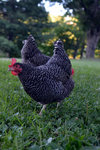 Narrowsburg
NarrowsburgLight Rain Fog/Mist, 43°
Wind: 8.1 mph
 Narrowsburg
Narrowsburg




Hey, chicken tenders! It’s Kristin, from the Chicken Librarian, here to tell you all about feeding those beautiful birds. If you caught us in the last Our County Home, you learned all about getting started with keeping chickens. This time, let’s dive in to discussing how to feed your birds. You’d think it was pretty straightforward, and it is, but there are a few things you need to know.
First, you bring home those babies and you wonder, “What do they eat?” It’s pretty simple. Start them on “chick starter feed.” They’ll be on this starter feed up until they’re about 6 weeks old. This feed has lots of protein in it (look for a feed with at least 20 percent protein) that helps the babies start life on the right foot.
Next, you will feed those growing babies “grower feed.” This feed will contain less calcium and protein, which is just what they need. Too much protein and calcium can cause kidney and liver issues. But let’s not be wasteful here. If you have starter feed leftover, you can mix it in with the grower feed until it’s gone. It’s also a good idea to not make the switch too quickly but, rather, gradually. Mix in a little of the grower mix at a time until you have completely switched them over. Feed them the grower feed until they are about to lay—at roughly 20 weeks old.
Now you are on to “layer feed,” and you know what that means, right? You guessed it! Those babies are about to be fully grown and laying eggs for you. Some chickens can take longer to lay, but you should start to see signs by 20 weeks of age. Of course, their nutritional needs are different now, too. At this stage, they need less protein and more calcium. Calcium is key when it comes to egg layers. So, do the same as you did for switching from starter to grower: gradually phase out the grower food until you are completely on a layer feed.
And once you get that first egg, start providing supplementary calcium. I hang a rabbit feeder on the wall of the coop with ground-up oyster shells (it’s a great source of calcium that can be purchased at your local feed store). However, there are many different ways you can provide calcium. A quick internet search will provide more ideas than you’ll ever need.
Once you’ve switched the chickens to the layer feed, that is all they will need from there on out. And if you have roosters in your flock, they will eat exactly what the hens eat—no need to feed them something different. Easy, right?
There are a few other things you need to know about feeding chickens. First, I would advise to not feed them anything other than chick starter for the first couple weeks of life.
But, wait a minute: If they’re hatched by a hen and raised by Mama Hen, don’t they start eating “treats” right away? They do. But there are a couple of reasons it’s different when you raise them inside. The first reason, and this is my theory, is that the birds (most likely) came from a hatchery where they are not living a natural life. They are in production mode and are not out on pasture. So, those chicks that are hatched at the hatchery need extra time to figure out what food is and what treats are. Believe me, it takes them a while. You have to teach them the things that they need to know, just as if you were Mama Hen—well, because you are Mama Hen!
Along those same lines, if they are hatched in your coop by Mama Hen, they will follow in her footsteps. So, she will teach them where to eat, what to eat, how to eat and everything that follows. So, I let them figure out where the food and water are, and then, after a week or two, I start adding in extra treats. And when you do add in treats, this is the time to start adding in grit. They need grit in order to crush up their food. Chickens don’t have teeth; they have crops where the food and water go to be ground down and passed through their system. And they need this grit to help grind the food.
Where do you get food, grit and calcium? You can find ready-made food at your local feed store, such as Agway, Tractor Supply, or Cochecton Mills. They have a wide variety of food, supplements and additives, including organic items. You can also purchase food online and have it shipped to you through companies such as Chewy. It’s amazing what you can get shipped.
You can also make your own food. It takes a lot of research to make sure you’ve come up with a correct formula, but in the end, it will be a money saver. No matter which route you go, make sure chicken feed is stored in a clean, dry container with a tight-fitting lid.
But you might be wondering if it’s OK to feed them kitchen scraps: yes! By all means, feed them your scraps and leftovers. I mean, that’s one big reason we have chickens. They can pretty much eat anything, including meat. They love meat. But let’s leave leftover chicken for other uses, m’okay?
Comments
No comments on this item Please log in to comment by clicking here